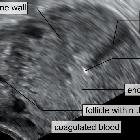abdominal ectopic pregnancy


Abdominal ectopic pregnancies are an extremely rare type of ectopic pregnancy.
Epidemiology
They are thought to represent ~1% of all ectopic pregnancies with an estimated incidence of 1:1000-10,000 births.
Pathology
It is often thought that they most frequently result from a tubal rupture with subsequent reimplantation of the conceptus onto bowel, omentum, or mesentery (in very rare situations primary abdominal ectopic may also occur). Uncommon cases when it develops as a result of a scar rupture have also been reported .
It typically develops around the ligaments of the ovary, on the uterus, or in the pouch of Douglas, although it can implant anywhere within the abdominal cavity. It can then obtain blood supply from the omentum and abdominal organs. At times these pregnancies migrate out of the pelvis and are seen in the upper abdomen. The placental attachment can also be at unusual sites including the anterior abdominal wall .
Risk factors
- previous tubal damage
- pelvic inflammatory disease
- endometriosis
- IVF
- presence of an intrauterine device
Radiographic assessment
Ultrasound
Ultrasound is often at the frontline of imaging. Sonographically the pregnancy is seen separate from the uterus, adnexa, and ovaries.
Fetal MRI
May have a role in better delineation of anatomy and relationships especially when the pregnancy is advanced.
Treatment and prognosis
It is a serious and potentially life-threatening condition. Maternal mortality associated with intra-abdominal pregnancy is estimated at 7.7 times that of other locations of ectopic pregnancy , with a mortality rate of ~5% .
Treatment is often by means of placental embolization followed by laparotomy or laparoscopy. While an abdominal pregnancy can result in a life-threatening emergency, especially when diagnosed late in gestation, it can also result in a live birth by means of a laparotomy .
Complications
- intra-abdominal hemorrhage with massive hemoperitoneum
Siehe auch:
und weiter:

 Assoziationen und Differentialdiagnosen zu abdominelle Extrauteringravidität:
Assoziationen und Differentialdiagnosen zu abdominelle Extrauteringravidität:


